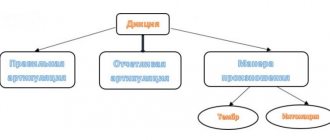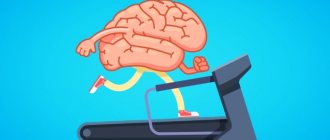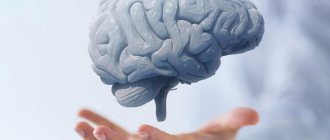When changes in the functioning of the brain become noticeable, and it becomes increasingly difficult to memorize and recall certain things, a person begins to think about what the problem might be and how to help return the brain’s performance to its previous level. You can improve memory and brain function in various ways, for example, through training, various puzzles, proper nutrition and medications. Let's look at the most effective of them, and also try to understand what aspects of life affect the proper functioning of this organ.
Exercises to synchronize the brain hemispheres
The main receptors with which we sense the world around us are located in our hands. Therefore, in exercises to synchronize the brain hemispheres, the hands will be involved first. Let's look at three exercises that are beneficial for the human brain:
- At the beginning, you should warm up your hands by rubbing your palms together. With your fingers spread out, touch the little finger of your right hand with the thumb of your left hand. With the thumb of your right hand, touch the little finger of your left hand. Now, move the thumb of your left hand to the tip of the ring finger of your right hand. Move the thumb of your right hand to the ring finger of your left hand. Then touch the middle finger of your right hand with the thumb of your left hand. With the thumb of your right hand, touch the middle finger of your left hand. The left thumb should now touch the right index finger. And the big right one is the left index. Everything can be repeated in reverse order, and then several more times, walking from the first toe to the last.
- The brain exercise continues. The second exercise is very simple. With your left hand, grab the tip of your nose. At the same time, hold your left earlobe with your right hand. Now quickly switch hands. The right hand holds the tip of the nose, the left hand holds the lobe of the right ear. Repeat changing hands several times.
- How to make the brain work equally well in both hemispheres? Do the third easy brain exercise. Take yourself with your right hand on your left earlobe, and with your left hand on your right earlobe. Holding your earlobes, squat at least 21 times. Bending your legs, inhale air, straightening your legs, exhale.
Repeat these three exercises every morning. It won't take you more than 10 minutes. But such a brain warm-up will help you synchronize both hemispheres. You will simply become a “terminator”.
Memory tests
Before you start doing memory training exercises, you can take a test task that will show how effectively you use your memory at this stage.
So, here is a list of 20 words that are not related to each other.
Teapot, Armchair, Piano, Boat, Soap, Orange, Carpet, Letter, Car, Stream, Cork, Weapon, Shoe, Brooch, Bag, Wing, Picture, Flower, Mixer, Medal.
You need to study the list of words for one and a half minutes, and then try to write them down in order. Next, count how many words you managed to remember correctly.
- 18-20 words is an excellent result.
- 17-15 is a good indicator.
- 14-10 – satisfactory result.
- Less than 10 - you are not using all memory resources, but the indicator can be improved.
In this form, this task is considered a test of visual perception, but it can also be used to test auditory memory. To do this, you need someone to pronounce the words out loud.
You can pass another test of visual memory using the picture below. Study it carefully for a minute, and then name the objects depicted on it in any order.
- If you named 18-20 objects, you have excellent short-term visual memory.
- 17-15 points is a commendable result; with the help of exercises, the volume of visual memory can be expanded even more.
- 14-11 points is a good indicator, but there is room for improvement.
- 10-5 points – average result, perhaps you should have focused better on the task at hand.
- From 1 to 4 points - your strong point is clearly not visual memory, you will have to train it hard, because we perceive a lot of information with our eyes.
Exercises to develop the right hemisphere of the brain
The development of the brain hemispheres gives a person the opportunity to solve complex problems faster than others, 5 and even 10 times. How to develop the right hemisphere? We learn from psychologists:
- The first exercise is called "Greeting to the General" . They salute with their right hand, as they do in the army. At the same time, show a sign of approval with your left hand. Thumb up, clenching the remaining fingers into a fist. The left arm is extended forward. Now you need to quickly change hands, salute with your left hand, extend your right hand forward, finger up. Swap hands several times.
- The second exercise is called: “Mushroom and glade” . The left palm is clenched in a fist, the elbow is on the back of the outstretched palm of the right hand. The right hand is positioned horizontally, at chest level. The left one is perpendicular to the top, the palm clenched into a fist, looking into your face. Swap your hands several times.
- The last movements are more like a tease or a joke . One hand calls out to the viewer, the other hand shows approval: thumb up, fist clenched. Now clap both hands, palm to palm, and switch hands. Show your approval with your other hands. Then again there is a clap and the figures change places. Repeat several times.
How does clearing the mind affect memory and cognitive abilities?
It is no secret that all creatures and people in particular have limited energy resources. Daily worries, work, everyday life undoubtedly take a lot of energy, but such things are necessary. Along with these energy costs, there are completely unnecessary expenses - so to speak, parasites are mental garbage. What is mental garbage? This:
- negative emotions (fears, anxieties, resentments, jealousy, anger, etc.)
- complexes (eg: I’m fat, I have crooked legs/teeth, etc.)
- limiting beliefs (“I can’t do this,” “that’s not how it’s done,” etc.)
- negative attitudes (many people have entire meta-programs for self-destruction, which provoke bad habits, destructive behavior, etc.)
- and much more
But this is just the tip of the iceberg. It is known that emotions absorb huge amounts of bioenergy. So what is the connection between clearing the mind and improving memory and cognitive abilities?
Firstly: a person in a depressed or spoiled mood has worse memory abilities (as well as cognitive abilities in general); secondly: limiting beliefs and ideas limit cognitive abilities; thirdly: mental garbage, eating up your energy reserves, again limits your ability to think and remember, because the more energy you have, the easier it is to memorize and the better your thinking in general.
To accelerate the purification of the mind, use the system -. The good thing about the system is that it uses the resources of the subconscious and, in fact, shifts the bulk of the work to it. And you basically just have to read ready-made instructions to the subconscious. Certainly an interesting thing.
Exercises to improve blood circulation in the brain
Gymnastics for cerebral vessels is needed if a person is diagnosed with vegetative-vascular dystonia. When blood circulation is impaired, the brain experiences oxygen starvation and becomes unable to work actively and correctly.
Dancing, yoga, the Nishi technique, simple movements with the arms, head, and legs help strengthen blood vessels, deliver more oxygen to the brain, and normalize blood circulation.
Light vibration immediately after waking up, without getting out of bed, expands capillaries and removes toxins from the body. To do this, you need to lie on your back, raise your legs and arms straight up, and shake them vigorously for about 5 minutes. The nerves that stimulate the brain are activated.
Waves with the whole body, as a swimming fish does, also perfectly activate blood movement. Sitting down, turn your head in both directions, alternately. Stand up and wave your arms and legs. Exercises for blood vessels are any movements: arms up, down, swinging your arms clasped together, as if chopping wood, increases the flow of blood to the head.
Walking, running, jumping rope, and dancing are useful for strengthening the blood vessels in the head.
Reasons for deterioration
Many factors in the modern world can impair memory
The following factors lead to memory impairment:
- emotional stress;
- systematic depression;
- lack of sleep;
- infectious diseases;
- vitamin deficiency;
- consumption of alcoholic beverages;
- smoking;
- brain injuries;
- taking medications (antidepressants, sleeping pills);
- diseases: atherosclerosis, thyroid dysfunction, multiple sclerosis, diabetes mellitus;
- aging of the body.
Exercises to develop visual memory
Drawing irregular patterns, solving puzzles and puzzles, dividing a complex picture into simple parts are wonderful exercises for developing visual memory.
The Chinese, in order to quickly remember the spelling of a hieroglyph, divide it into several parts. It is easier to remember individual parts. Mentally putting them together, you get the overall picture. So it’s easier to remember a stranger’s appearance if you remember the color of his jacket, shirt, jeans and shoes.
Visual memories become stronger if they are complemented by color, smell, and the melody that sounded at that moment. Remembering a beautiful pear, you will involuntarily feel its taste.
Comparing pictures that are slightly different from each other trains attention to detail and strengthens visual images.
By duration:
Short-term. A small amount of information is quickly remembered and just as quickly disappeared. The data is stored for up to approximately 30 seconds and without repetition can disappear forever.
Long-term. Information can be stored for quite a long time: from several hours to several years. But banal cramming without quality study of the material does not help here. Long-term memory requires conscious detailed learning, mental interpretation, and association with existing knowledge.
Operational. Memory is stored for a certain period of time while processes or actions are performed. It differs from short-term in that it regulates certain activities and is used to maintain its intermediate results.
Exercises for memory development in preschoolers
The brain needs to be trained at a very young age. When a child assembles a pyramid of rings, having repeated the construction of this structure several times, he will soon remember that first he must put the largest donut on the pin, then smaller ones, and the smallest ones on top. A cone or asterisk is installed on the top.
Learning short rhymes, like:
“A clubfooted bear is walking through the forest,
He collects pine cones and sings a song.
Suddenly a cone fell, right on the bear’s forehead,
the bear got angry and kicked: stomp!
It's very fun to imitate the gait of a bear, hit yourself on the forehead and stamp your foot in the right place. These simple manipulations add visual and motor memory to auditory memory.
Fairy tales with frequent repetitions: “A mouse for a cat, a cat for a bug, a bug for a granddaughter, a granddaughter for a grandmother, a grandmother for a grandfather, a grandfather for a turnip,” develop auditory and visual memory, if you look at a colorful book with pictures.
Compiling pictures from puzzles develops attention to detail and visual memory. The child constantly has to compare a piece of the drawing with the general image.
How to develop additional types of memory
It is worth paying attention to the smells, trying to remember them along with the visual image. Tactile sensations also allow you to remember better; touch is used to activate tactile memory.
Memory works effectively if you use several of its subtypes at once. An important wedding date can be said out loud in the form of an emotional sentence - “I put on the ring on the second of May!” Auditory memory records vivid expressions better. Then write the same phrase 3-4 times, in letters of different sizes. Visual memory will automatically record differences in texts with identical content. It is better to add a drawing to the text that will be remembered better than words - a wedding ring with a date inside. The selection of associations will help to consolidate the result: the second number - two people, May - spring - love - wedding.
Training memory and attention in adults - the best exercises
Classes to improve memory in adults are not such a difficult task. If you wish, you don’t have to waste extra time on training attention in adults. Listen carefully to your friend, trying to remember the color of his shirt, shoes, coat, eyes, hair. After you part, try to remember these colors.
While walking down the street, try to remember the numbers of buses or cars passing by. If you are stuck in a traffic jam or have a long ride on a trolleybus, solve crosswords and scanwords. They perfectly train memory and attention.
Memorize three words of a foreign language every day. Learn poetry, read at least 20 pages a day. These simple ways train the brain and memory of busy adults.
Try not to overwork and eat right. Fresh fruits and vegetables, greens, a lean diet, enough calories, a varied menu are necessary to nourish brain cells.
Cheese, milk, sausage...
Try to do without the usual paper grocery list on your next trip to the store. The authors of the book “Super Memory for Everyone,” Ekaterina and Vladimir Vasiliev, advise: you need to memorize not the long line “cheese, milk, sausage, cabbage, onions, mushrooms, flour, bread, cookies,” but divide it into three groups of three products.
“ Divide information into groups of 3-4 elements . You can remember much more if you group them into chains. Associated with this is the custom of dividing, for example, telephone numbers into 2-3 digits. It has long been known that three is the optimal number.”
Repeat. Say it to yourself or out loud . Repeat the name of a new acquaintance when he introduces himself, say the sequence of actions to yourself before starting a new activity. Speak your way when you go out on business: “to the post office – to the pharmacy – to the newsstand – to the electronics store.” This way you won't forget anything.
Use different types of memory and mnemonics. Everyone who remembers the colors of the rainbow using the phrase about a hunter and a pheasant knows about mnemonics. Many long, complex lists can be remembered much easier by applying mnemonics to them - just connect the facts with some funny nonsense , this will be firmly fixed in memory, the authors of the book about super memory are convinced.
Brain exercises for older people
Brain exercises for older people are quite simple. Read fairy tales and retell them to your beloved grandchildren, memorize with them children's funny poems about “The Absent-Minded One from Basseynaya Street.” It's fun and enjoyable, and it also preserves your personality.
Intelligence training prevents a person from losing his skills and knowledge. It's not just our muscles that need warming up. Neurons restore their connections and do not die if the brain is loaded with feasible work.
You shouldn’t get too tired, but collecting pictures from puzzles, learning foreign words, walking in the park along an unfamiliar alley, remembering a new route, is necessary for good attention. Doctors recommend brushing your teeth and combing your hair either with your left hand or with your right. Simple experiments, but effective.
Good nutrition and fresh air will be the best helpers for you and your mind. Individuals who lead an active lifestyle do not suffer from senile dementia.
Healthy lifestyle
Poor memory and mood, absent-mindedness - all this can be a consequence of excessive fatigue, poor nutrition, lack of oxygen and fluid, a sedentary lifestyle, as well as excessive weight. That is why, for memory and brain function more efficiently, many doctors recommend adhering to a healthy lifestyle, proper nutrition and daily routine. Without these components, brain training may be useless.
You should also understand that bad habits cause great harm to brain performance, especially smoking and drinking alcohol. If you decide to improve your memory, they should be eliminated from your life completely.
Let's look at several ways to improve brain performance by improving your functioning.
Physical exercise
According to scientific research, heart contractions during physical activity send 20% more blood to the brain than during a sedentary lifestyle. Along with blood, oxygen enters the cells, which is necessary for their vital functions and active work.
Scientists have also determined that breathing exercises help activate the hippocampus, the part of the brain responsible for memory. At the same time, the best effect from aerobic breathing exercises can be achieved precisely when playing sports.
In addition, oxygen supplied during physical activity allows the central nervous system to produce a specific protein that is responsible for the development of brain cells and their lifespan as such.
According to research, daily jogging and morning exercises will significantly improve brain performance and memory quality. And all thanks to the activation of blood circulation and improved nutrition of brain cells.
Healthy food
Many types of food have a positive effect on the brain and its performance. Some of them begin to act quickly and short-term, while others improve the activity of this unique organ in the long term.
The first group includes chocolate and other sweets that contain magnesium and glucose - two important microelements that quickly stimulate brain cells and allow them to work in an enhanced mode for a short time. If you decide to increase activity in the long term, then you need to constantly consume nuts, which deliver the necessary microelements to the cells. Experts also recommend adding foods to your menu that contain the following natural stimulants:
- Vitamins of groups D, E, P – known as bioflavonoids;
- B vitamins – folic acids, which improve the general condition of the brain;
- Vitamins of group C are stimulants for cell function.
The greatest amount of vitamin B can be obtained by eating the following foods: greens, liver, eggs, dairy products, red fish and poultry. The latter also contains dopamine, which provides a sufficient amount of energy not only for mental, but also for physical activity.
If you decide to significantly improve your memory and the performance of brain cells, then in addition to the products listed above, include foods containing serotine: tomatoes, dates and figs, soybeans, bananas. All these plant products will give you a boost of energy and good mood.
There are a lot of natural stimulants for memory function, here are the main ones:
- Oatmeal and millet cereals, rice, buckwheat are foods rich in carbohydrates, metals and vitamin B;
- Seafood – phosphorus and fatty acids, vitamin B;
- Cocoa is a source of flavanol;
- Nuts, almonds, cashews – lecithin, healthy fats, vitamin E;
- Cabbage – vitamins PP and B, various beneficial types of acids;
- Green tea is a source of antioxidants;
- Wild berries are a source of huge amounts of vitamins and antioxidants;
- Garlic - phytoncides help in the fight against diseases of blood vessels;
- Nightshades, especially tomato, are a source of melatonin;
The main thing is to understand that foods containing unhealthy fats, for example, fried pork or boiled lard, clog blood vessels, which means they do not allow the brain to function properly. In general, essentially all food that causes obesity and leads to excess weight also negatively affects the functioning of brain cells, so it should be excluded from your diet.
Healthy sleep
Special attention should be paid to sleep. This part of human life is very important for the body. With a lack of sleep, all organs suffer, and primarily the brain. During sleep, the brain analyzes and processes information received during the day. Without proper rest, it is very difficult to remember something new, and even more so to process fresh information. In addition, it is insomnia and improper sleep patterns that can lead to the development of mental and psychomotor diseases.
The place to sleep should be comfortable, the room should be warm and dark, in this case falling asleep will be easy. Sleep should be preceded by a relaxing and calm indoor environment. It should also be understood that the best time to sleep is at night; daytime sleep is not effective and has a negative impact on a person’s performance.
Many scientists argue that it is the lack of healthy sleep that has the worst effect on brain performance and causes cell destruction. Even alcohol and nicotine, which destroy a huge number of neurons, have less negative effects than regular insomnia. That is why, along with nootropics, doctors often prescribe various sleeping pills or antidepressants with a similar effect. For example, Phenibut, which has a great effect on brain health and promotes healthy sleep.











